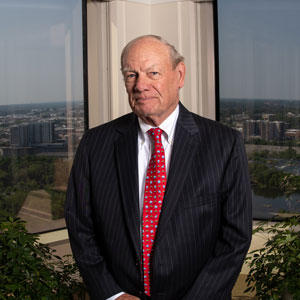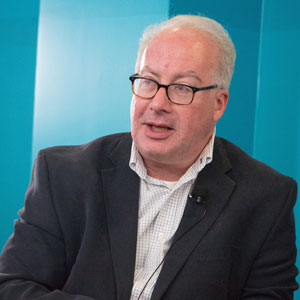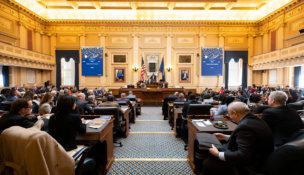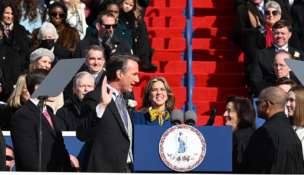The Powell Memo
Did this document put big business in the political driver’s seat?
Mason Adams //July 30, 2021//
The Powell Memo
Did this document put big business in the political driver’s seat?
Mason Adams //July 30, 2021//
The Powell Memorandum has been praised and vilified, denounced as a blueprint for business to seize control of American life, and embraced as a way to protect liberty and free enterprise.
Whether because of its lasting influence or alarming prescience, the Powell Memorandum has become one of the most important single documents in understanding the embrace
between American politics and business over the last half century.
Yet, 50 years since it was written in 1971 by a highly respected Virginia lawyer and future U.S. Supreme Court associate justice, the memo remains shrouded in mystery. Political analysts and historians sharply disagree on its actual level of influence. The debate itself testifies to the enduring power of the concise yet comprehensive 34-page document that outlined why and how corporate America could — and should — assert influence over American politics, society and culture.
“Rarely has any memorandum or position paper been more successful, more influential than the Powell Memorandum,” says A.E. Dick Howard, the University of Virginia’s Warner-Booker distinguished professor of international law.
“It was one of the first statements of the culture war,” says political analyst Bob Holsworth.
Memo mythology
The Powell Memorandum was written for the U.S. Chamber of Commerce by Lewis F. Powell Jr. A Richmond-area corporate lawyer and partner in the law firm that is now Hunton Andrews Kurth, he served as president of the American Bar Association from 1964 to 1965.
A spokesman for Powell told The New York Times in 1972 that he wrote the memo at the request of Eugene B. Sydnor Jr., a Richmond businessman and chamber official who was also Powell’s neighbor and close friend.

Titled “Attack on American Free Enterprise System,” the resulting document counsels a multifaceted strategy encompassing media, government, courts, higher education and corporate structures to counteract rampant anti-business sentiment.
“We are not dealing with sporadic or isolated attacks from a relatively few extremists or even from the minority socialist cadre,” Powell writes. “Rather, the assault on the enterprise system is broadly based and consistently pursued. It is gaining momentum and converts.”
Initially, the memorandum received little attention. That changed a year later in 1972 when syndicated newspaper columnist Jack Anderson published excerpts from the memo in his political column, “Washington Merry-Go-Round,” after Powell had been nominated to the U.S. Supreme Court in 1971 by President Richard Nixon.
The publicity brought the memorandum to the attention of businessmen who enacted a wide-ranging program along the lines of what Powell had recommended. The Powell Memorandum was eventually credited for playing a role in the emergence of conservative institutions that reshaped the political landscape. In turn, the document became a rallying point for the political left to fundraise against and build its own institutions.
Today, the Powell Memorandum is wrapped in a blanket of mythology complicated by 50 years of political rhetoric, blame-casting and hindsight.
Consensus builder
By the time he wrote the memorandum bearing his name, Powell already had devoted three decades to public service, including three years as a military intelligence officer with the U.S. Army Air Forces during World War II and 25 years as a partner at Hunton, Williams, Gay, Powell & Gibson, the forerunner of Hunton Andrews Kurth.
In addition to being an active member and leader of the American Bar Association, Powell chaired the Richmond School Board and tried to dissuade U.S. Sen. Harry Byrd from his Massive Resistance strategy opposing racial desegregation of Virginia public schools. Powell also served most of a decade on the Virginia Board of Education.
Allen Goolsby began working with Powell when he started at Hunton Andrews in 1968.
“Of all the people I have met, he was the most conscientious and hardest working,” Goolsby says. “He basically worked seven days a week. I remember being told that he would go to church on Sunday, but he would only go for the sermon — and then he’d go back to work.”
Howard worked with Powell on the commission that drafted a rewrite of the Virginia Constitution, approved by voters in 1971. The redraft was largely undertaken to eliminate racially discriminatory policies such as school segregation.

“At every meeting, Lewis Powell was invariably the best briefed and best prepared, no matter the topic,” Howard says. “It might be something he knew about like education, or corporations and finance. If it was an area he wasn’t familiar with, he was well briefed all the same. He was the voice of — not compromise, but reconciliation, bringing views around the table together.”
“He was very lawyerly in the way he thought about things,” says John Jeffries, a U.Va. law professor and Powell’s biographer. “The typical Lewis Powell participation would be to let everyone else speak and then at the end to sum up.”
President Nixon nominated Powell to the U.S. Supreme Court in 1971 to succeed Associate Justice Hugo Black. Powell’s ensuing 15-year term included the 7-2 Roe v. Wade decision that legalized abortion. (Powell voted with the majority, affirming a pregnant woman’s right to choose an abortion.)
Probably his most famous opinion came in Regents of the University of California v. Bakke, which upheld affirmative action and allowed colleges to incorporate race as a factor in admissions. The case had split the court, but true to form, Powell won consensus with a Solomonic opinion that found that the Constitution allowed affirmative action while striking down the specific program in question.
“Powell was in the majority more than any other justice while he was in the court,” Jeffries says. “It wasn’t because he moved to the majority; it was because the court was balanced so that it swung whichever way he voted. He was a fulcrum, not a swing.”
During his Supreme Court term, Powell drew deeply on his knowledge of corporate law in ways that echoed the Powell Memorandum. In the majority opinion on First National Bank of Boston v. Bellotti, Powell wrote for the majority that corporate influence of elections through campaign contributions represents free speech covered by the First Amendment. The case has had long implications on federal law and court rulings ever since, notably influencing the Supreme Court’s landmark 2010 Citizens United decision.
Battling commies and leftists
Compared with Powell’s reputation as a consensus builder, his Powell Memorandum reads like a polemic. The first part lays out the case that free enterprise was under assault by “communists, New Leftists and other revolutionaries who would destroy the entire system, both political and economic.”
“He was kind of a conservative corporate lawyer and someone shocked by the hippies,” says Mark Schmitt, former editor of the liberal and progressive public policy magazine The American Prospect and a self-identified “Powell memo debunker.” “He was like a lot of older established men of that era, who were comfortable with the liberal consensus of the post-war era but saw something a lot freakier coming along.”
The memo called for a more aggressive response from corporate America, with strategies across business, government, politics and the legal system.
“Its genius is a recognition that you have to build institutions,” Schmitt says. “Corporate America didn’t think of itself as building institutions to engage in political fights [and] legal fights. He [Powell] spotted all the areas where … arguments about the direction of the country were going to happen.”
The memo’s comprehensive nature, relatively short length and concise language make it stand out even today. However, immediate response to it was muted.
“I don’t think anything of great consequence within the chamber ever came of it,” says Goolsby. “He listed a bunch of items they could undertake. I don’t think they did any of them. It wouldn’t have been effective.”
Jeffries says, “There is not a long trail” of paperwork about the memorandum in Powell’s personal papers. “If I had seen in the papers any evidence of impact at the time he wrote it, that would have been very prominent in my mind and in the biography.”
Others have found traces of the memorandum’s influence on key right-wing figures.
In her 2016 book “Dark Money: The Hidden History of the Billionaires Behind the Rise of the Radical Right,” writer Jane Mayer quotes businessman and political activist Charles Koch from a 1974 speech: “As the Powell Memorandum points out, business and the enterprise system are in trouble, and the hour is late.”
Mayer writes that other wealthy conservatives were likewise inspired by the Powell Memorandum. Joseph Coors reportedly was prompted by the memo in 1973 to establish the conservative think tank The Heritage Foundation, but Schmitt discounts the memo’s role more as a “minor contribution” that “pushed him [Coors] in a direction he was already going.”
“I’ve found a few more traces of real actual influence at the time, but it’s still a fiction to treat it as a blueprint for the conservative movement,” Schmitt says.
Whose memo is it anyway?
While Schmitt is skeptical about the idea that the Powell Memorandum served as a blueprint for the growth of the conservative movement that found full flower during Ronald Reagan’s presidency in the 1980s, he agrees that the memo did play a major role in building up institutions — but ironically on the political left in the 21st century.
“There were a group of progressive fundraisers brought together after the 2004 elections,” Schmitt says. “They went to rich people with a PowerPoint and made the case, ‘Here’s what the right built; we have to build something similar.’”

This reaction to the Powell Memorandum is exemplified in a 2012 issue of The American Prospect, published when Schmitt was not part of the magazine. The cover depicts a black-and-white photo of Powell with hand-scrawled devil horns and a forked tail.
In the cover story, the magazine’s editors argued, “The Powell Memo must be reckoned as one of the most successful political directives in history.” The issue featured 19 essays that laid out how to match the “revitalized conservative movement” with action on the left.
The American Prospect issue stands out for its stark vilification of Powell, but its umbrella assumption that his memorandum sat at the core of conservative institution-building has been echoed in numerous left-leaning books and publications.
“I find it appalling,” says Jeffries. “To be completely and perhaps unwisely candid, I think people love conspiracy theories.”
What is undeniable is that more than two decades after his 1998 death, Powell and his ideas are as relevant as ever. A new Supreme Court is taking up cases on issues with which Powell wrestled, including affirmative action and abortion.
Moreover, the vision for action he outlined in the Powell Memorandum has come to fruition. The political right and left both have built robust institutions that produce research and talking points, cover news through an ideological lens, put forward judges, conduct political operations and educate the next generation.
Powell also foresaw how corporations would be challenged by societal, cultural and political movements such as diversity and climate change. Indeed, some of the movements that Powell identified as threats have been thoroughly absorbed into the culture of business.
“Environmental and safety regulations have made cars much safer, and we have cleaner air,” Holsworth says. “It turns out that all of that is consistent with the capitalist system.”
Powell would welcome other developments, such as the emergence of activist public interest law firms and the expansion of laws protecting the rights of corporations. Those changes sprang largely from Powell’s writing in 1971, says Howard — a fact that would have gratified the Richmond lawyer.
Click here for Virginia Business’s interactive, annotated version of The Powell Memo
l
















